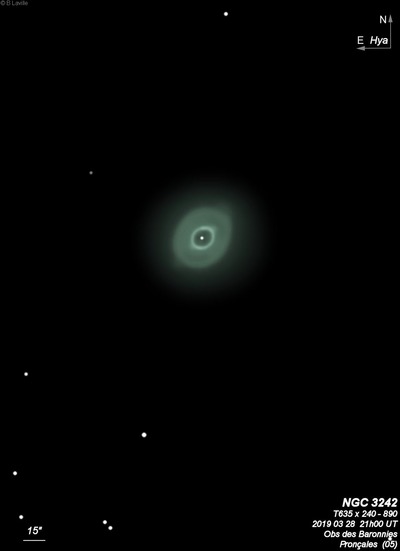Jupiter's Ghost Nebula
Jupiter's Ghost Nebula

William Herschel discovered NGC 3242 = H IV-27 = h3248 on 7 Feb 1785 (sweep 368) and described this bright planetary as "a beautiful, very brilliant globe of light; a little hazy on the edges, but the haziness goes off very suddenly, so as not to exceed the 20th part of the diameter, which I suppose to be from 30 to 40" in diameter. It is round, or perhaps a very little elliptical, and all over of an uniform brightness: I suppose the intensity of its light to be equal to that of a star of the 9th magnitude." On a second observation he logged "Beautiful, brilliant, planetary disk, ill defined, but uniformly bright, the light of the colour of Jupiter. 40" diameter. Second observation, near 1' diameter by estimation." Interestingly, this is perhaps the only example where WH referred to a color in a planetary.
William Lassell observed NGC 3242 on 12 Mar 1853 with his 24-inch equatorial reflector on Malta and noted "a brilliant light blue colour with slight green tinge." The double ring structure was described at Birr Castle, as well as the northwest extension of the inner ring. On 6 Apr 1863 Samuel Hunter logged,"Outer ring is brightest north and south and fainter preceding, but vF on sf side, it does not appear so blue as the inner and brighter one....The little projection of np end of the bright ring is very marked." E.E. Barnard and Sherburne Burnham observed the planetary with the 36-inch at Lick Observatory on 25 Feb 1889. Barnard described in his logbook "a glowing star in center of dark space, this in in parallelogram or diamond shape () of beautiful bluish green. This in an elliptical rose colored disc."
Admiral Smyth noted the planetary "resembles Jupiter" in his "Cycle of Celestial Objects" (1844), following Herschel’s comment. But the nickname "Ghost of Jupiter" was apparently first used by Captain William Noble. In the 1882 issue of Knowledge, he wrote "It will be a seen as a pale-blue disc, looking just like the ghost of Jupiter." He repeated this description in "Hours with a Three-Inch Telescope" (London and New York, 1886). William Tyler Olcott also stated "It will be seen like a pale blue disk, like a ghost of jupiter" in his 1909 book "In Starland with a Three-Inch telescope”.
Based on Crossley photographs at Lick, Curtis (1918) reported "the inner, roughly elliptical ring with its slightly fainter extensions is about 26"x16" in pa 145°. The outer and considerably fainter oval disk is 40"x35", and shows faint ring or shell effects at its edges.
300/350mm - 13.1" (3/24/84): very bright, bright inner lens surrounded by a second fainter elliptical shell. At 350x there is a darker center to the inner lens and the central star is visible almost continuously.
400/500mm - 17.5" (3/25/00): this beautiful PN has a very high surface brightness and a bluish color at 100x. The view at 280x-380x is stunning with a well-defined double shell structure. The bright, narrow inner ring is surrounded by a second fainter oval envelope. Inside the bright lens is a dark, 10" donut-hole with a faint central star marking the center. In moments of steady seeing, the inner ring has a hard-edge and the central star is easier.
17.5" (1/31/87): at 415x appears very bright, fairly small, bluish color, central star is visible. Prominent double lens structure with a bright inner lens surrounded by a second fainter elliptical shell. Stunning at high power with a striking "eye" appearance with a darker center.
900/1200mm - 48" (4/18/15 and 5/1/19): In addition to the structure previously noted, the sharply defined inner ring clearly has lower surface brightness extensions at the northwest and southeast end, creating an inner lens. The bulge on the northwest end is a bit larger and brighter, though the southeast end of the ring has a slightly brighter knot.
Two galaxies are nearby. PGC 155202, 3.9' SSW of NGC 3242, is fairly faint, fairly small, slightly elongated NNW-SSE, 20"x15", very weak concentration. A mag 11.2 star lies 1.9' NE. PGC 155215, 3.4' SE of NGC 3242, is faint, small, slightly elongated WNW-ESE, 15"x12", low surface brightness. A mag 14 star lies 0.6' WNW and a mag 10 star is 2' E.
48" (2/18/12): at 814x, the multiple ring structure was remarkable. The small, dark central hole and bright central star was surrounded by a beautiful inner lens, elongated 3:2 NW-SE, ~25"x15". This vivid turquoise lens was brighter at the ends of the major axis and bulges out with an extension on the northwest end. Surrounding the lens was a broader halo or shell with a rounder outline, ~45"x35" NW-SE. This shell had a distinctive light pink or salmon color. Highlighting the very edge of this shell is an extremely thin, slightly brighter greenish ring. A low surface brightness outer halo surrounds the planetary.
48" (4/1/11): stunning view at 488x with a high contrast, high surface brightness double ring structure and an outer third shell. The small inner lens has an electric turquoise color and is elongated 3:2 NW-SE, ~25"x15". At the southeast end of the major axis of the inner ring is a well-defined, bright knot. The irregular inner ring is also brighter and thicker along the northwest end, though not as bright or sharply defined as the southeast knot. The dim central portion is punctuated by the bright central star. The outer ring is rounder and extends ~45"x35" NW-SE, with the limb unevenly lit. The greenish color is not as intense in the outer ring. Between the two main rings the nebulosity has a pinkish hue. The main structure was surrounded by a low surface brightness outer halo, at least 1.5' diameter, which significantly increased the total size!
Notes by Steve Gottlieb